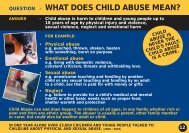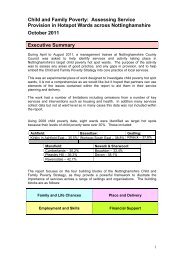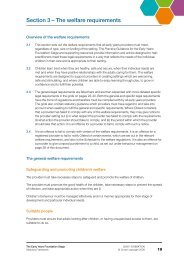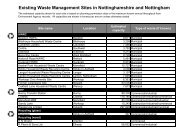Nottinghamshire Working with Fathers Strategy
Nottinghamshire Working with Fathers Strategy
Nottinghamshire Working with Fathers Strategy
You also want an ePaper? Increase the reach of your titles
YUMPU automatically turns print PDFs into web optimized ePapers that Google loves.
<strong>Nottinghamshire</strong> <strong>Working</strong><strong>with</strong> <strong>Fathers</strong> <strong>Strategy</strong>
Contents<strong>Nottinghamshire</strong> <strong>Working</strong> <strong>with</strong><strong>Fathers</strong> <strong>Strategy</strong>1. Context 52. Vision 63. Rationale 74. Systematic Engagement 95. Inclusive, Responsive, Respectful Services 116. Supporting Staff to be Father Inclusive 147. Reviewing Father Inclusiveness 15Appendix 1 The Fatherhood Institute 17Appendix 2 What the gender equality duty means for family services 18Appendix 3 Parental Responsibility 19Appendix 4 <strong>Working</strong> <strong>with</strong> <strong>Fathers</strong> <strong>Strategy</strong> Group 213
1. CONTEXTWhy this strategy?This strategy has been published to help local childrenand young people’s services and other relevant agenciesunderstand and implement our vision for father-inclusiveservices. It is aimed at commissioners, strategic andoperational managers and staff in a very broad range ofservices including both children and young people’s andadult services.The strategy sets out a framework for working <strong>with</strong>fathers in <strong>Nottinghamshire</strong>, and should be read inconjunction <strong>with</strong> the overall Parenting Support <strong>Strategy</strong>A note on languageThroughout this document the term ‘father’ is used toinclude biological fathers (whether resident of not) andnon-biological fathers and father figures (e.g. adoptivefathers, foster fathers, stepfathers, grandfathers, malecarers) who are significant in a child or young person’slife. This also includes expectant fathers and fathers whodo, and do not, have legal Parental Responsibility.The process to dateWork on developing this strategy was initiated bypractitioners from <strong>Nottinghamshire</strong> Children’s Centreswho began to meet together <strong>with</strong> partners in each districtto share ideas and develop practice around working <strong>with</strong>fathers. This network collaborated <strong>with</strong> Trent University toorganise a practitioner event which was attended by 80+practitioners from partner organisations and was wellreceived by those who attended. Links were established<strong>with</strong> the Fatherhood Institute as Children’s Centre teamsbegan to use their baseline assessment tool to informand shape their work. A series of training programmesprovided by the Teenage Pregnancy service supported thedelivery of father-inclusive services on the ground.In order to progress the work further and to inform acounty-wide model for fathers of all children and youngpeople aged 0-19, a second practitioner event was heldin 2008 <strong>with</strong> the support of the Fatherhood Institute. Amulti-agency steering group was established includingrepresentation from the districts which has continued tooversee this work. Current membership of the steeringgroup can be found in the appendices.“Our Family Resource Worker, Geoff, helped me and mywife to understand our children's needs more. We nowdo more activities together as a family andcommunicate better.”5
2. VISION“Perhaps the best thing a dad can do - maybe the bestthing I want to do - is to help my children reach their fullpotential - maybe as a dad I want to reach my fullpotential. I want to be a great dad and celebrate it.”Source: Anthony Driver, DVD 2009 [Title to be decided],<strong>Nottinghamshire</strong> County Council.Our vision is that all Children’s Services in<strong>Nottinghamshire</strong> will enable fathers to participatepositively in the lives of their children and youngpeople.All agencies and individuals in <strong>Nottinghamshire</strong> working<strong>with</strong> families need to be father inclusive – which meansthat they are committed to improving children and youngpeople’s welfare by systematically and routinelypromoting strong, positive relationships between fathersand children and young people, and supportingconsistency in parenting between fathers and mothers,whether living together or not. This is in line <strong>with</strong> formerChildren’s Minister Beverley Hughes’ call for localservices to think distinctively about fathers rather thantreating them as the ‘invisible parent’: “Let’s make surewe ‘think fathers’ in every service we deliver and everypolicy we unveil.”This requires an appropriate range of universal andtargeted family services to meet the diverse needs oflocal families and communities, delivered at the earliestpractical point to build opportunity for fathers and theirchildren and young people, and working in partnership<strong>with</strong> adult services.All local children and young people’s services shoulddraw on the best available research evidence of what iseffective at supporting father-child relationships, andtherefore will be expected to:services should be accessible to all fathers, whatevertheir background and family situation.• Be responsive: all services should be sensitive to theindividual needs and experiences of different fathers.• Be respectful: all services should value and respectindividual fathers’ views, beliefs, strengths, knowledgeand concerns about their children and young people.• Involve fathers as partners in the design, delivery,evaluation and development of all their services.• Support staff to be father inclusive. All staff will besupported to develop the skills, knowledge and valuesnecessary to work effectively <strong>with</strong> fathers, throughappropriate recruitment, training, information andsupervision.• Regularly review how effective all their services are atengaging <strong>with</strong> and supporting fathers.This father-inclusive vision should be adopted by all localagencies, following active consultation and discussion<strong>with</strong> all staff, managers (at all levels), service users,partner agencies and community groups. Once adopted,agencies should ensure that the vision is publicisedeffectively in all their literature and displayed in all theirsettings. A lead individual responsible for implementingthis vision should be identified in all agencies.We recognise that this involves a substantial change inwhat is expected of local service providers. This strategyrepresents our best aspirations for working <strong>with</strong> fathers in<strong>Nottinghamshire</strong> and establishes a framework to supportservices in working to achieve them.• Engage systematically <strong>with</strong> fathers: all services forfamilies should “engage <strong>with</strong> both father and motherexcept where there is a clear risk to the child to do so”[see DCSF’s Children’s Plan, Box 1.1], and worktogether to offer fathers an integrated andcomprehensive range of services.• Be inclusive: “irrespective of the degree of involvementthey have in the care of their children, fathers shouldbe offered routinely the support and opportunities theyneed to play their parental role effectively”. [EveryParent Matters, Para 3.11]. This means that all6
3. RATIONALE• Having an involved father has been found to beassociated <strong>with</strong> children having better peerrelationships, fewer behavioural difficulties, and lowerlikelihood of criminality and drug use later in life• Good parenting at home and fathers’ involvement inschooling has been found to be important for childrenand young people’s educational attainment,particularly for children and young people fromdisadvantaged backgrounds• Children gain from the different qualities whichmothers and fathers bring. This is particularly the casefor boys: the absence of involved male carers isbelieved to contribute to levels of disaffection amongsome adolescent boys.Source: 21st Century Dad, Equal OpportunitiesCommission, June 2006The evidence now shows clearly that fathers are animportant influence - which can of course be positive ornegative - on children and young people’s and mothers’wellbeing1. It is also clear that the way services engage<strong>with</strong> fathers impacts on their behaviour, attitudes andconfidence as parents: and that in turn affects childrenand young people, mothers, and fathers themselves.This research base underpins the current strong nationalpolicy framework requiring local authorities to adopt astrategic and joined-up approach to engaging <strong>with</strong>fathers and supporting their relationships <strong>with</strong> theirchildren and young people.<strong>Fathers</strong> influence through:• their direct relationship <strong>with</strong> each child or youngperson;• the time, money and skills they bring, or do not bring,to the household;• the support they give, or do not give, to mothers; andtheir relationship <strong>with</strong> them;• their networks of family, friends, colleagues.Today’s fathers do eight times more caretaking of infantsand very young children than fathers did 30 years ago(now an average of 2 hours on a weekday in the UK).When both parents work, dads do a third of the parentalchildcare. Involved, ‘good enough’ fathering (like ‘goodenough’ mothering) helps children and young peopledevelop better friendships; fewer behavioural problems;better educational outcomes; greater empathy; higherself-esteem and life-satisfaction; lower criminality andsubstance abuse; less traditional attitudes to earning andchildcare; and greater resilience after parentalseparation. This is true for resident and non-residentfathers.Positive fathering benefits mothers too. It is associated<strong>with</strong> mothers being less stressed and depressed, andbonding better <strong>with</strong> their children. Conversely, a negative(or lacking) father-child relationship is associated <strong>with</strong>less positive outcomes in all these areas.It follows that it is important to identify and engage <strong>with</strong>all fathers in local families. But it is also true thatchildren and young people in disadvantaged familiestend to suffer more than better-supported children andyoung people from no relationship (or a bad one) <strong>with</strong>their father; and to benefit more when it is substantialand positive. There is also good evidence that serviceswhich engage well <strong>with</strong> fathers make a substantialdifference to outcomes for children and young people,mothers and fathers themselves. When fathers engage<strong>with</strong> services, they are likely to:• feel more confident as fathers• understand more about child development• spend more time <strong>with</strong> their children and young people• be more sensitive and positive <strong>with</strong> them• be more supportive of their child or young person’seducationFor example, delivering a parent education programmeto both parents is significantly more effective thandelivering it to just one. Both parents’ sensitivity towardstheir child or young person is enhanced when bothparents are worked <strong>with</strong> rather than only one.Father inclusiveness is also required by the GenderEquality Duty, effective from 6 April 2007. This statutoryduty requires all public authorities, including thosecommissioning parenting services, to have “due regard”to the need to promote equality of opportunity betweenmen and women2. Gender equality does not requiremen and women to receive the same service – there arecircumstances where needs are different. But genderequality does mean that neither women nor men shouldbe excluded from support they need.7
What influences whether fathersengage <strong>with</strong> local children and youngpeople’s services?Like mothers, fathers are particularly open to this atcertain life stages, notably in the ante and postnatalperiod. But fathers at other stages in the family life-cyclealso express interest and enthusiasm; e.g. fathers whoare addressed in workplace settings, imprisoned fathers,fathers of children and young people <strong>with</strong> disabilities,young fathers, and fathers of young children.When engagement <strong>with</strong> fathers is not successful, it doesnot follow that fathers do not want a service. There aremany possible reasons for their non-engagement,including:Father-specific factors: their sense of identity as fathers,their knowledge about the importance of their role, theirknowledge of local services and beliefs about whetherthey will be welcoming for fathers, their commitment as afather, their relationship <strong>with</strong> own father/mother, theirmental and physical health, their employment status,involvement in criminality/drugs/alcohol, or domesticviolence, etc.Couple-relationship factors: relationship commitmentand cooperation, mutual support, residence/contactarrangements (where parents live apart)Mother-specific factors: her employment, attitudetowards and expectations of the father, support providedto father etc.Child-factors: attitude towards father, behaviouraldifficulties, temperament, age, gender, developmentalstatusLarger contextual factors: how services are delivered(e.g. opening hours, venue, working practices),employment opportunities (including whether longabsences from home are required), economic factors,race/ethnicity resources and challenges, culturalexpectations and social support.8
4. SYSTEMATIC ENGAGEMENTSystematic engagement <strong>with</strong> fathers (includingexpectant fathers) is essential to achieving the EveryChild Matters outcomes. Effective pathways for fathersto engage <strong>with</strong> all family services are therefore a coreelement of good practice.Effective engagement <strong>with</strong> fathers depends on identifyingboth the bridges and barriers to them getting involved inyour services. If you are not currently in contact <strong>with</strong>many fathers, this does not mean that they are notinterested. They may be unaware of your services, orthink they are aimed at mothers, or do not understandwhy getting involved might benefit their children andyoung people. You need to overcome these barriers, andconstruct effective ‘bridges’ to all fathers.1. Referrals and Record-keepingService providers cannot systematically engage <strong>with</strong>fathers unless they have their contact details. Allchildren and young people’s services should routinelyand systematically seek to record information aboutfathers in all the families they come into contact <strong>with</strong> –through referral, self-referral or outreach – unless to doso would involve a clear risk to the child or person orother family members. This applies to all fathers,whether or not the father is currently resident or incontact <strong>with</strong> his child or young person, whether or notthey have Parental Responsibility, and whether or not thefather is believed to be a risk to the child or youngperson or mother.In <strong>Nottinghamshire</strong>:• All referral and registration forms should providespaces for the name, and contact details of the‘mother’, the ‘father’, and other key carers.• These forms should also contain spaces to record otherrelevant information about fathers (as well as mothers).• All staff <strong>with</strong> responsibility for filling in these formsshould ensure that they routinely seek to gather andrecord information about fathers.• Staff working <strong>with</strong> young people will routinely askyoung men if they are a parent or have parentingresponsibilities• When an agency receives a referral that does notcontain information about the birth father and keyfather figures, this should be routinely questioned <strong>with</strong>the referring agency to acquire the information (ifknown), or to agree which agency will gather theinformation.• The use of both registration and referral forms shouldbe monitored by all agencies to ensure that thisinformation is being gathered effectively.For more information on how to develop a fatherinclusive approach to referrals and record keeping,please consult the Practice Guidance associated <strong>with</strong>this strategy2. Signposting and ‘Consent toContact’All family services should actively encourage signpostingof fathers from other local agencies (including both adultand children and young people’s services) that men arein contact <strong>with</strong>: eg from antenatal services, schools,Connexions, homelessness projects / hostels, Citizens’Advice Bureaux, GPs, local employers, etc. Adultservices should themselves already be taking account ofthe needs of their service users as fathers (and mothers)when delivering services and assessing needs3.9
In <strong>Nottinghamshire</strong>:All family services should develop their own ‘Consent toContact’ form, and encourage other local agencies touse it routinely as part of their signposting procedures forfathers, especially those in vulnerable families.3. Publicity, Outreach and HomeVisiting<strong>Fathers</strong> tend to be much less well informed about localfamily services than mothers, and assume that they are‘not for them’. All workers/volunteers in family servicesshould take responsibility for routinely telling fathers whatyou offer, and encouraging them to attend your services.They should also encourage mothers to invite fathers toengage <strong>with</strong> your services.In <strong>Nottinghamshire</strong>:• All literature about services should directly address andappeal to men.• All leaflets/newsletters about services for familiesshould include male images and the word ‘dad’ or‘father’, emphasise why fathers are important and thatthey are welcome.• All workers/volunteers in family services, and other localagencies in contact <strong>with</strong> men, should have access to agood supply of leaflets about all local services, androutinely give them to all fathers and mothers they arein contact <strong>with</strong>.• All home visiting services should be organised to beaccessible to fathers, and used routinely to engage <strong>with</strong>them.• At home visits, workers should proactively engage <strong>with</strong>fathers who are present, explaining that the service isfor them as well as the mother.• If the father is not present the worker should discuss<strong>with</strong> the mother how to arrange future visits toencourage him to be present.• These home visiting services should also routinely seekto engage <strong>with</strong> non-resident fathers.10
5. INCLUSIVE, RESPONSIVE, RESPECTFUL SERVICESLocal children and young people’s services shouldsystematically take account of local fathers’ specificneeds and concerns. They should routinely offerfathers the support and opportunities they need to playtheir parental role effectively - whatever theircircumstances and the degree of involvement theycurrently have in their children and young people’slives.They should also recognise that mothers and mothers-tobeare strong influences on children and young people’srelationships <strong>with</strong> their fathers, and routinely engage <strong>with</strong>them on fatherhood issues.1. Core featuresServices should attempt to engage <strong>with</strong> all fathers infamilies they are in contact <strong>with</strong>, and not see theirengagement <strong>with</strong> fathers as problem-focused. Thisincludes both resident and non-resident fathers, andthose <strong>with</strong> or <strong>with</strong>out Parental Responsibility.In <strong>Nottinghamshire</strong> all services should:• respond to individual fathers’ complex and changingneeds• involve a mixture of universal and male-targetedservices to meet fathers’ different needs, circumstancesand preferences• be developed <strong>with</strong> different types of fathers in mind inorder to engage effectively <strong>with</strong> fathers’ diversity• aim both to promote positive parenting by men, and toreduce men’s risk to mothers and children and youngpeople• be as positive and non-stigmatising as possible• have an active partnership <strong>with</strong> local fathers. Thismeans involving fathers throughout in the design anddelivery of all services.Services should pay particular attention to designingservices relevant to:<strong>Fathers</strong> who may be at risk of poor outcomes, or whosechildren or young people may be at risk of pooroutcomes; including disabled fathers, fathers <strong>with</strong>disabled children, teenage fathers, fathers from blackand minority ethnic communities, fathers <strong>with</strong> childrenfrom black and minority ethnic communities, fathers whoare asylum seekers, separated fathers, fathers who havemental health or substance misuse problems, fatherswho use violence in their families or in the community,fathers who have been in prison or are known to beengaged in criminal activity, fathers who live in poverty orin workless households.<strong>Fathers</strong> at key transition points; including pregnancyand birth, children and young people starting/changingschool or becoming teenagers, teenagers becomingparents, parental separation, becoming a step-father,changing/losing employment, resettlement into thecommunity after a significant absence, e.g. from prison,the armed forces.For more information on the core approaches requiredin the main service sectors, please consult the PracticeGuidance associated <strong>with</strong> this strategy.2. Service SettingsAll agencies should ensure that the settings in which theydeliver services do not alienate fathers:In all <strong>Nottinghamshire</strong> service settings:• décor should not be clearly ‘feminine’ in style• baby-changing facilities should be easily accessible fordads, and signposted in such a way that they knowthey’re allowed to use them• there should be a male toilet marked (or if there is onlyone, it should be clearly marked for use by both sexes)• positive images of fathers and children and youngpeople should be clearly displayed, as well as readingmaterials that take male needs and interests intoaccount• male-friendly toys should be available; e.g. constructiontoys, a mini football table• consideration should be given to providing a specificdad-identified space where fathers can congregate.It will often make sense to deliver some services aimed atfathers in other local venues that men may feel morecomfortable in; e.g. sports facilities and swimming pools,playgrounds and parks, community centres, youth clubsetc. Outdoor events and trips away can also help getround the issue of creating male inclusive settings, andbe a great source of fun and togetherness.11
Where possible, services should engage local fathers indesigning and building the physical spaces used to offerservices. Services should encourage local dads, mumsand children and young people to help adapt settings,including providing photos of dads <strong>with</strong> children andyoung people.3. When to organise men-only servicesChildren and young people’s services should generally bedesigned to be equally welcoming, accessible andrelevant to both fathers and mothers. Some separateservices for fathers should also be available, but it is notpractical or effective to set up substantial parallel servicesfor men and women. Moreover, there are many benefitsto both sexes using at least some services in common.Where fathers use services (as equal partners, not as”visitors”) alongside women, this helps local communitiesand families to see fathers as central in their childrenand young people’s lives. In fact, services just for fathersare unlikely to succeed unless other agencies andservices are also engaging <strong>with</strong> fathers, and working <strong>with</strong>other family members on the issue of fatherhood.Where venues are used mainly by female service users,and staffed mainly by women, it can be appropriate todeliver some services for fathers only. Many dads feel‘out of place’ and ‘on show’ when they attend familyservices mostly used by women, or simply feel that theservice is not really for them. Some fathers do not feelconfident as parents, and think that looking afterchildren – especially younger ones - is in some way‘women’s business’. These men often feel morecomfortable attending group or one-to-one servicesspecifically for dads, run by staff who are particularlycomfortable and skilled at engaging <strong>with</strong> men.Some mothers and staff may feel uncomfortable aboutservices for fathers only and perceive them as beingexclusive. However many services offer activities forcertain groups for reasons to do <strong>with</strong> empowerment andbuilding their confidence and skills. Father-only servicescan be offered on a similar basis to enable fathers toresource themselves to resource their child or youngperson.<strong>Fathers</strong> may use father-only services for a variety ofreasons:• for contact time• because the interaction between them and their childor young person is different to when the mother is alsopresent• it enhances bonding• they enjoy a different style of play or activity• their time <strong>with</strong> their child or young person is moreprotected and there are less interruptions• they enjoy male support• they feel more confidentThese father-only services should also form an important‘bridge’ to other local services (through referrals andsignposting, and through staff in all relevant servicesattending the father-only service periodically). Separatetime-zones for fathers can also help when women fromsome cultural groups cannot attend if male non-relativesare present or when mothers need a women-only spaceto feel safe and supported.Ongoing fathers groups work very well for some men,and should be available to new and existing serviceusers. <strong>Fathers</strong>’ groups work best if the worker gives thefathers a strong sense of ownership and acts as afacilitator, not an expert. More intensive groups areunlikely to attract large numbers of fathers, but are animportant support for some fathers.Case Study 1: Inclusion SupportService Autism TeamThe Dads’ Forum was set up in October 2006 by a smallgroup of dads. The dads wanted to create a group whichwould enable them to share knowledge, experiences andinformation and they wanted to be able to meet socially.The group has been steadily growing in numbers so aplanning / review meeting was held. The report includeseveryone’s views.What has been useful about the group.• Meeting other dads, sharing information and support.• Listening to other dads’ experiences• The bowling nights have been a great laugh – the onlytime over the last few years I have been able to dosomething like that.• Finding out more through people that have been / arein a similar position to me.12
• Being kept in touch <strong>with</strong> courses events and speakers.• The group makes me get out.• Really good having some fun time away from thefamily.• The group is needed.• The meetings in the pub have been great.• Chatting to other dads and the information on theinternet.Kieran LeeCase Study 2: Ladybrook Children’sCentreOver a period of time we realised that groups at theChildren’s Centre were seldom accessed by fathers.Ideally, we would have asked dads why they didn’t useour services, but it was very difficult to find dads to talkto, so we developed a strategy to try to make theChildren’s Centre more appealing to them. We:• reviewed the images on display in the centre andincluded more positive images of dads.• included information for and images of dads in ourliterature including our newsletter.• made reference to Dads and Family frequently ingroups• looked for specific ideas which might prove attractive todads• offered targeted group activities for dads on a regularbasis.for Saturday mornings. Activities like visits to the firestation and local football team were arranged. Thesewere successful but demanding in terms of staff time andnot inclusive.Dads attending the sessions remarked that it would benice to have a family event. This gave us the opportunityto move things forward and three family sessions werearranged during which we worked hard to promote thewhole programme at the Centre. Individual events forDads have continued, mostly arranged <strong>with</strong> the Parent’sForum.For us working <strong>with</strong> Dad’s groups has:• provided an opportunity to integrate dads into othercentre activities• offered a forum in which specific issues can be airedwhich may not surface in a mixed group• provided opportunities for dads to find out that thecentre is not just a place for mums• given dads the confidence to feel part of the centre• been a place where dads, many of whom appearedquite socially isolated, could make friends• given dads a chance to experience and learn from ahigh quality play and learning experience <strong>with</strong> theirchildren• provided some dads <strong>with</strong> a route to other organisationsand services available to them.Noel Proud – Community Involvement CoordinatorThe first four were straightforward, the activities were lessso. We were conscious that we wanted these to be apathway into participation in Family Matters for fathersand other male carers and not to evolve separately to theexisting provision. At the same time they would need tobe gender specific initially, since the input we had beenable to obtain suggested that it was very difficult for aman to walk into a group of women and they did notalways feel welcome.We set up five weekend sessions which were targeted atmen, called them the Dad’s Group and scheduled them13
6. SUPPORTING STAFF TO BE FATHER INCLUSIVEAll services should develop their workforce to beconfident and skilled at engaging <strong>with</strong> fathers.Recruitment, induction, training and supervision shouldbe used systematically to strengthen their knowledge,skills and attitudes in supporting father-childrelationships.The key qualities staff need in order to engage well <strong>with</strong>dads are largely the same as they need for any directwork <strong>with</strong> families (good interpersonal skills, empathy,commitment etc.), but many workers display suchqualities more readily <strong>with</strong> female service users. This canbe due to lack of awareness about how important fathersare to their children and young people (and how theyimpact on mothers too), lack of clarity that it is a corepart of their role to engage <strong>with</strong> and support fathers, orinexperience or negative experiences <strong>with</strong> men.Family services need to ensure that all their staff haveclear guidelines about their role in engaging <strong>with</strong> andsupporting fathers, and are informed about why fathersare important to children and young people. Of courseindividual staff roles and responsibilities <strong>with</strong> fathers willvary and more complex issues should be addressed bymore experienced workers. The key is to work welltogether as a team. Services can support each other byworking in partnership; for example, a children’s centreworking <strong>with</strong> a male community development worker torun sessions and offer support.Do workers engaging <strong>with</strong> men have tobe male?No. Women can work very successfully <strong>with</strong> fathers. Mostdads say skills and attitudes matter most, and some evenprefer a female worker. But male workers can ‘model’caring for children and young people as a male activity,bring a male perspective to service provision and helpmale service users feel ‘at home’. Male workers andvolunteers should be people local fathers can identify<strong>with</strong>, or accept as their advocate. Male and femaleworkers working co-operatively can also be powerful rolemodels for male and female service users.Recruitment and Job DescriptionsRecruitment practices can be used to embed theexpectation that all members of the workforce willengage <strong>with</strong> fathers as well as mothers.In <strong>Nottinghamshire</strong>:• All job descriptions and job adverts should be reviewedto ensure that they refer to ‘mothers’ and ‘fathers’ (notparents) and explicitly state that these roles involveengaging <strong>with</strong> and supporting fathers.• Person specifications should all reflect the qualitiesneeded to support father-child relationships effectively;understanding and valuing the role fathers play in theirchildren’s lives and being committed to supportingfather-child relationships.• Where there is a specialist fatherhood worker, servicesshould define their specific responsibilities carefullyincluding how their role integrates <strong>with</strong> and issupported by colleagues’ roles.Supervision, Training and On-the-jobSupportAll workers should be given opportunities to build theirskills and confidence at engaging <strong>with</strong> fathers.In <strong>Nottinghamshire</strong>:• All supervision sessions in family services shouldroutinely address engagement and non-engagement<strong>with</strong> fathers through the use of clear ‘prompt’questions.• There should be ongoing whole team training aboutdifferent aspects of father inclusive services, wherepossible on a multi-agency basis.• Training should include building skills and knowledge,as well as personal reflection to explore staff attitudesto engaging <strong>with</strong> fathers14
7. REVIEWING FATHER INCLUSIVENESSCompliance <strong>with</strong> the Gender Equality Duty requiresgathering information on how services impact onwomen and men respectively and consulting <strong>with</strong>women and men who use services in ways they findaccessible.Monitoring and evaluation of all family services needs toprovide data on both outputs (processes) and outcomes(impact) in relation to engagement <strong>with</strong> fathers. This isessential to the development and delivery of services thatare effective at supporting father-child relationships.Key outputs (processes) to measure are:• Local needs assessment: does the service establish theneeds and interests of different groupings of localfathers and their children and young people?• User involvement: to what extent have specificgroupings of fathers been involved in designing theservice?• Information: to what extent does information forservice users and referral agencies specify that theservice is for fathers as well as for mothers?• Policy statements: to what extent do the policies,mission and objectives of the agency reflect an explicitand clear determination to engage <strong>with</strong> fathers?• Materials: to what extent have any materials used bythe service been checked for their relevance to fathersand evaluated by male service users?• Referrals and signposting: to what extent do referralsand signposting forms contain contact information andother relevant information about fathers?• Referral criteria: to what extent do referrals take intoaccount the needs of the whole family in decidingwhether to make or accept a referral?• Assessment: to what extent are agencies assessing theneeds of fathers once a referral has been made?• Contact: To what extent have fathers accessedservices?• Service design: Are services available at times and inplaces that fathers can access and feel welcome? Hasthe need for any dedicated service for fathers beenassessed?fathers, mothers, children and young people and thewider family focus on the need to strengthen a positivefather-child relationship?• User feedback: are the views of different types offathers about the services gathered? Are children andyoung people / mothers / other family membersencouraged to express their views about the ways inwhich services include fathers?• Engagement <strong>with</strong> other agencies: to what extent arelocal service providers referring on to a wide range ofagencies?• Staff attitudes and behaviour: are there positive staffattitudes towards engaging proactively <strong>with</strong> fathers?• Staff recruitment, training, support, supervision andappraisal: to what extent does staff recruitment specifythat staff need to have the skills to work <strong>with</strong> fathers?Is there specific training around engaging <strong>with</strong> fathersavailable for all staff? Has consideration been given toproactively recruiting male staff? Is the issue ofengagement <strong>with</strong> fathers routinely addressed in staffsupervision and appraisal? Do staff feel their needs interms of safety, out of hours working etc. are beingaddressed?The outcomes or impact of father-inclusive servicesshould be assessed both in terms of the impact onfathers themselves, the impact on mothers and/or othercarers and the impact on children and young people.Key outcomes (impact) to measure for fathers are:• Knowledge and understanding: to what extent havefathers increased their knowledge and understandingof child development and other relevant issues?• Self-efficacy: do fathers feel more confident and morecompetent to undertake their parenting role?• Satisfaction: do fathers feel more satisfied <strong>with</strong> thefather-child relationship and <strong>with</strong> their relationship <strong>with</strong>their child or young person’s mother and other familymembers?• Behaviour: Have fathers changed their behaviour inrelation to themselves; e.g. stopping smoking, or inrelation to their child or young person; e.g. increase inpositive activities?• Interventions: to what extent do services working <strong>with</strong>15
The provision of father–inclusive services will also impacton many National Indicators in relation to adults. Forexample;• NI 6• NI 9• NI 32• NI 119• NI 151Participation in regular volunteeringUse of public librariesRepeat incidents of domestic violenceSelf-reported measure of people’soverall health and well-beingOverall employment rate<strong>Working</strong> <strong>with</strong> colleagues from other services to developstandard methods of data collection that take intoaccount an individual’s parenting status may help toassess the impact of father-inclusive service provision inthe future.Many of the outcome measures above can also be usedto examine the impact of father-inclusive services onmothers and/or other carers. For example; do mothersfeel more confident in undertaking their parenting rolewhen there is a supportive and engaged father involved<strong>with</strong> their child?There are also a number of National Indicators relatingspecifically to mothers where the provision of fatherinclusiveservices may have an impact. For example;• NI 53 Prevalence of breast-feeding at 6-8weeks from birth• NI 126Early access for women to maternityservicesKey outcomes to measure for children and young peopleshould be contained <strong>with</strong>in the Children and YoungPeople’s Plan (CYPP) and the impact of father-inclusiveservices on these outcomes should form part of theperformance management framework for the CYPP.16
Appendix 1The Fatherhood InstituteThe Institute (charity reg. no. 1075104) is the UK’sfatherhood think-tank, whose vision is for a society thatgives all children a strong and positive relationship <strong>with</strong>their father and any father-figures; supports both mothersand fathers as earners and carers; and prepares boysand girls for a future shared role in caring for children.You can also contact them on 0845 634 1328, or atenquiries@fatherhoodinstitute.org.The Institute:• collates and publishes international research onfathers, fatherhood and different approaches toengaging <strong>with</strong> fathers by public services andemployers;• helps shape national and local policies to ensure afather-inclusive approach to family policy;• injects research evidence on fathers and fatherhoodinto national debates about parenting and parentalroles;• lobbies for changes in law, policy and practice todismantle barriers to fathers’ care of infants andchildren;• is the UK’s leading provider of training, consultancyand publications on father-inclusive practice, for publicand third sector agencies and employers;The Fatherhood Institute is available to help you meetthe challenges and make the most of the opportunitiespresented by father inclusiveness. It offers a variety ofconsultancy and training options, and a range ofpublications, more details on which can be found ontheir website:• strategic training and consultancy:http://www.fatherhoodinstitute.org/index.php?id=0&cID=687• practitioner training:http://www.fatherhoodinstitute.org/index.php?id=0&cID=686• workers’ helpline:http://www.fatherhoodinstitute.org/index.php?id=0&cID=320• publications:http://www.fatherhoodinstitute.org/index.php?id=0&fID=417
Appendix 2What the gender equality duty meansfor family servicesThe Gender Equality Duty (Equality Act 2006), effectivefrom 6 April 2007, requires all public authorities,including those commissioning parenting services, tohave “due regard” to the need to promote equality ofopportunity between men and women. Official guidanceto the Duty is available athttp://www.eoc.org.uk/default.aspx?page=19951.“Promoting” means being active and not passive: thestatutory equality body and inspectorates will look foraction and positive change as evidence of compliance.“Having due regard” means prioritising attention inproportion to its relevance. Supporting both mothers andfathers in caring for children is relevant to genderequality: The lack of sharing of caring responsibilitiesbetween women and men (women do more) is the singlebiggest driver of the pay gap, according to analysis bythe Equal Opportunities Commission. Supporting fathersto take on more of the responsibility for caring forchildren, therefore, is a key contribution to genderequality.on women and men. This will assess if there is evidenceof different needs between women and men and whetherboth women and men’s needs are being met. It will alsolook at the gender norms and stereotypes that are beingassumed. (The Equal Opportunities Commission is soonto publish specific guidance on impact assessment.)Compliance <strong>with</strong> the Duty includes gathering informationon how services impact on women and men respectivelyand consulting <strong>with</strong> women and men who use services,in ways they find accessible. The compliance of localauthorities <strong>with</strong> the Duty in parenting services will beactively monitored, along <strong>with</strong> compliance in othersectors.For more about the Gender Equality Duty go to:http://www.equalityhumanrights.com/advice-andguidance/public-sector-duties/introduction-to-the-publicsector-duties/gender-equality-duty/Some men, particularly if they are very young, black,separated, mentally ill or from socially excluded families,experience real exclusion from family services – and thedetriment to them, their partners and their children issignificant.Children who experience diverse male and female rolemodels in their lives will have wider horizons andopportunities as they grew up.Gender equality does not require men and women toreceive the same service – there are circumstances whereneeds are different. But gender equality does mean thatneither women nor men should be excluded from supportthey need. The Gender Equality Duty requires publicauthorities “proactively to address the individual needs ofwomen and men in all their functions” (officialguidance).Under the law, local authorities need to publish anoverall scheme and action plan for promoting genderequality, covering all areas where gender equality issuesare deemed to be relevant.More particularly, at the point of commissioningparenting services, a gender impact assessment isrequired, assessing the differential impact of the service18
Appendix 3Parental ResponsibilityWhat is it?Parental Responsibility (PR) is a legal status an adult canhold in relation to a child, which gives that adult thelegal authority to make decisions about importantaspects of the child’s life. These can include their name,school, religious upbringing and place of residence.Having PR does not, in itself, entitle a parent to live <strong>with</strong>or see their child; but a father who has it may beregarded more favourably by a Court, if this issue comesto it.Who has it?All married parents of both sexes have PR automatically,as do all adoptive parents and all mothers. An unmarriedfather doesn’t unless:• His name is placed on the birth certificate either atinitial registration or at re-registration later - as long asthis happened after 1 December 2003. This requiresthe mother’s agreement.• Both parents have signed a Parental ResponsibilityAgreement (PRA). This is done by agreement <strong>with</strong> themother.• He has obtained a Parental Responsibility Order (PRO)from his local County Court. The Court can order this<strong>with</strong>out the mother’s agreement.Since 93% of fathers now sign their children’s birthcertificates, most fathers of younger children now havePR. Grandparents, step-parents, same-sex partners andother people <strong>with</strong> day to day care of a child can also beawarded PR. This does not take away PR from eitherparent.What difference does PR make?Although day-to-day, a father’s PR status tends to makelittle difference, fathers <strong>with</strong>out PR can’t authorizemedical treatment for their children, see their medicalrecords, manage any money they’ve inherited, or preventtheir adoption or change of surname or removal abroad.A father’s lack of PR can also:• undermine his involvement in his children’s lives wherethis is most at risk - eg when the parents separate;• make it less likely that agencies concerned <strong>with</strong> hischildren’s welfare will engage <strong>with</strong> him as a risk or as aresource for them;• mean he must obtain PR through the courts to be ableto take care of his children officially, if their mother diesor leaves. Except in the relatively small number ofcases where the father’s involvement is very harmful, itis generally positive for children and their parents iffathers acquire PR early on, preferably at the birth.The Role of Family ServicesMany parents don’t understand what PR means, andwrongly assume that a father has it. So it’s important todiscuss and explain it (signposting to good legal advice ifnecessary), and encourage their consideration of thefather acquiring it - remembering that it is the mother’sdecision, unless the father applies to a court. Thisprocess also encourages parents to reflect on theirexpectations of the father’s role. Both mothers andfathers may have concerns about the dad getting PR.Mothers may worry it will mean loss of control, andshould be able to discuss their anxieties <strong>with</strong> you (youmay learn lots about the family in the process). Legally,his having PR doesn’t affect her right to make day-to-daydecisions and doesn’t mean he can override her wishes.Where they can’t agree on major issues, then they wouldneed to go to court - which is also likely to happen if hedoesn’t have PR.<strong>Fathers</strong>’ anxieties may include the fear that seeking PRmight:• harm their children: in an unstable situation, willasking for PR make things worse?• harm the mother: if she’s on benefits, will his gettingPR reduce her access to them? (The answer to this isno).• harm themselves: will he have to pay (more) childsupport? Or will that contact <strong>with</strong> ‘the law’ expose himto deportation, prosecution etc.?• undermine the family’s sense of his commitment (dadfeeling less involved, mum less secure and moreresponsible);19
Why family services need to know who has PRYou need to know who has PR:• to identify who is legally responsible for childrenregistered <strong>with</strong> you;• to clarify whether you need to address the issues aboutPR explored above• to be clear whether you have a legal right or duty toprovide information to the father (eg if anyone else<strong>with</strong> PR tries to tell you not to)• because discussion of PR can help you identify whethera man is a biological father or a father-figure, and findout more about his role in the family.Although provision of information to fathers about theirchildren can be affected by their PR status in certainlimited situations (e.g as we’ve already mentioned, afather <strong>with</strong>out PR has no legal right to see their child’smedical records), PR isn’t the be-all and end-all. Forexample, DfES Guidance makes clear that all parents(<strong>with</strong> or <strong>with</strong>out PR) have a right to participate indecisions about their child’s education, including beingtreated equally concerning access to information (pupilreports, parents’ evenings etc), unless there is a courtorder limiting this right. In general, however, whether afather has PR should make little or no difference to theservices you offer him. Your agency should offer allfathers the support and opportunities they need to playtheir parental role effectively – irrespective of their PRstatus and the degree of involvement they currently havein the care of their children.20
Appendix 4<strong>Working</strong> <strong>with</strong> <strong>Fathers</strong> <strong>Strategy</strong> GroupNameDistrict/OrganisationTy YousafNaran RathodAdisa DjanClaire AllisonJenny Spencer/Rick ScottPaul GoodmanLinda MottishawNicola HughesNicola TurnerJude BurgessWayne StevensonWendy EvansSue FentonSally Moorcroft / Tracy MullaneyAlison SissonNatasha MellorsTony StevensRhonda Schofield-Teal / Dawn WebbJane Goreweda/Michelle SquiresSally PennJo Voce/Yvonne HaydenNeelum Ahmad/ Denis TullyNoel Proud/Marion KavanaghBrian Matthews/Diane Tinklin/Jan DerbyshirePeter Cook/Susan HillierSocial CareInclusion Support ServiceConnexionsNHS <strong>Nottinghamshire</strong> CountyYouth Offending ServiceExtended ServicesSpecialist Family SupportFamily Information ServiceIntegrated Services Team<strong>Nottinghamshire</strong> Children’s CentreTeenage PregancyParentline plusHomestartNAVOACLSIntegrated Services TeamEducation Welfare ServiceFamily Intervention ProjectAshfieldBassetlawBroxtoweGedlingMansfieldNewark & SherwoodRushcliffe21
Contacting usemail nicola.turner@nottscc.gov.ukphone 01623 433195post Children’s Services, Meadow House, Littleworth Mansfield, <strong>Nottinghamshire</strong>NG18 2TBinternet www.nottinghamshire.gov.ukpublished October 2009photos PA/John BirdsallCYPCOM 2803












![Every Parent Matters [PDF 463KB] - Nottinghamshire County Council](https://img.yumpu.com/47250686/1/184x260/every-parent-matters-pdf-463kb-nottinghamshire-county-council.jpg?quality=85)


![School Employee Domestic Violence and Abuse Policy [PDF 228KB]](https://img.yumpu.com/46294446/1/184x260/school-employee-domestic-violence-and-abuse-policy-pdf-228kb.jpg?quality=85)
